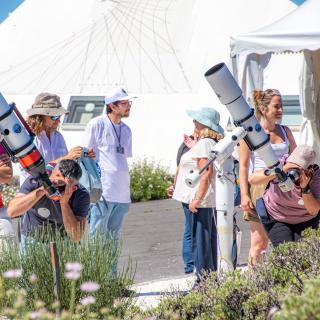The Canaries will invest in this telescope, one of the key instruments, recognized world-wide, among the major Scientific and Technological Facilities which are unique in a Spanish context
The Director of the Canarian Agency of Research, Innovation and the Information Society (ACIISI), Juan Ruiz Alzola, the Director of the Instituto de Astrofísica de Canarias (IAC), Rafael Rebolo, and the Director General of Gran Telescopio de Canarias S.A. GRANTECAN), Pedro Álvarez, made a presentation this Friday, 16th January, of the scientific activities programmed between the years 2014-2020 after the signing of three collaborative agreements.
Juan Ruiz Alzola announced that “The Canary Government will invest more than 20 million euros in one of the reference telescopes, recognized throughout the world, of the major Scientific Installations, which are unique anywhere in Spain, i.e. the GTC”. He went on to explain that “any investment in this type of installations will help to bring in new international investors in astronomy, and will contribute to the leadership of the Canaries in this sector, which implies that we must continue to work to maintain the high international status we enjoy today".
The ACIISI has signed three agreements, co-financed by FEDER, one for the sum of 1,920,000 euros for the adaptive optics system on the GTC, and two others with GRANTECAN for phases I (5,495,000 euros) and II (13,410,000 euros) in the programme of augmenting the equipment on the GTC. In 2015 the extension of Phase 2 for the system of adaptive optics for this telescope (2,690,000 euros) will be also performed.
The Director of the IAC, Rafael Rebolo, stated that the Ministry of Economy and Competitivity (MINECO), via its Secretariat of Research, Development and Innovation, is fulfilling its promise of providing support to the running costs of the GTC. He explained that “This, together with the contributions from the Canarian Government, will consolidate the GTC in the coming years as one of the most versatile and competitive telescopes in the world". He also expressed his satisfaction that the University of Florida had now resumed its contributions to the operational costs of the GTC, and that it had shown its firm intention of continuing to be an active partner in the telescope, as well as for the development of a new instrument for observing in the near infrared, which has recently begun its installation phase. “The GTC” he said “continues its upward curve of scientific publications, and we are confident that during 2015 this will continue to be favoured by two further new instruments, in this case developed by the IAC: the multiobject infrared spectrograph EMIR, and the very high resolution optical spectrograph HORS. “These instruments, and the new programme of developments for multiobject spectroscopy in the optical and infrared, and for adaptive optics during the period 2015-2019 complete a very important and balanced instrument package."
Pedro Álvarez underlined the fact that the finance now approved by the Canarian Government via the ACIISI ensures the continued improvement of the GTC during the coming years. “With these funds” he explained, “we will maintain and enhance the attraction of this scientific installation for the research teams in future years. This is the only way to take advantage of the opportunity for the GTC to continue to perform the best possible science before the giant telescopes presently under construction begin to function, some time during the next decade."
This funding is designed to complete the capability of the telescope, giving it new instruments such as EMIR, FRIDA and adaptive optics, MEGARA, or MIRADAS. All of them are instruments which will allow the GTC to tackle research programmes not feasible until now, and which in many cases will not be feasible on telescopes of similar size. “In this way” Álvarez concluded,"we will resolve a situation in which the telescope lacked badly needed instruments which are essential to its future. We hope that in the near future we will be able to obtain improvements to the level of annual operational funding of the telescope which has suffered from the cut-backs of recent years.”
FURTHER INFORMATION
The Canarian Agency for Research, Innovation, and the Information Societyof the Canary Autonomous Regional Government is financing, with an investment of 5,495,000 euros Phase 1 (2013-2015) of the plan to augment the equipment on the Gran Telescopio Canarias. At the end of this first phase, which will last until October 2015, the GTC will have four working focal stations, the two Nasmyth foci already operating, plus two folded Cassegrain foci, with a different scientific instrument at each of the foci: OSIRIS, CanariCam, CIRCE, and EMIR.
In addition, last December the Government approved a loan of 13.410.000 euros to GRANTECAN to cover the funding of Phase 2 of the programme to augment the equipment on the GTC, with the aim of providing it with new scientific instrumentation to cover the needs speficied by the scientific user community, and for the supporting elements required by the new instruments.
To implement this loan a new agreement has been signed between GRANTECAN and the ACIISI, which will allow the second phase to be carried out, and the GTC will finally have five working foci (the two Nasmyth foci already in operation, two folded Cassegrain foci developed during the first phase, and the main Cassegrain focus to be developed during this second phase) and with scientific instruments operating at each of them: OSIRIS, CanariCam, CIRCE, HORS, EMIR, FRIDA, plus MEGARA and MIRADAS, which will be constructed during the second phase.
This equipment will give the GTC the capability of carrying out astronomical observations in the visible, the near infrared, and the thermal infrared ranges. This programme will thus put into practice some of the recommendations (those considered short term) put forward in 2008 and 2013 by committees of international experts set up to guide the future development of the telescope.
The third collaborative agreement follows from the approval by the Regional Government of repayable loans to the IAC, of 610,000 euros, and to GRANTECAN of 1,310,000 euros, in order to carry out the project “A System of Adaptive Optics for the GTC”.
The objective of the project is to complete the development of a system of adaptive optics for the GTC in order to achieve satisfactory performance of the FRIDA instrument, presently under construction by a consortium led by the Astronomical Institute of the National Autonomous University of Mexico, in collaboration with the IAC.
The system of adaptive optics will be situated at one of the Nasmyth foci of the telescope. Its role is to correct, in real time, the deformation of the optical wavefront proceeding from an astronomical source caused by atmospheric movements, and to yield as its output a stable image from which the effects of atmospheric turbulence have been effectively eliminated.
This project is being carried out in response to the demands of the scientific community, and the recommendations of international experts. The GTC is the telescope which allows the Spanish scientific community, as well as the communities in the University of Florida and in Mexico to carry out astronomical observations in direct competition with the most advanced instruments in the world.
THE ENTITIES INVOLVED.
The Canarian Agency of Research, Innovation, and the Information Society offers more than 20 million euros in funding between 2014 and 2020 for projects in the context of this major Scientific and Technological Facility here in the Canaries. The terms of this refundable loan are designed to facilitate investments in R+D+I using FEDER funding. The Canarian Government will provide the complete fund, in anticipation of the funds requested, and once the investment by the company has been justified and certified by the Government against European funds, the European Union will then give 85% and the beneficiary needs to return only 15% of the original loan.
Gran Telescopio de Canarias, S.A., is a mercantile society with public investment capital, with 50% participation by the National State Administration and 50% by the Autonomous Regional Government of the Canaries. Its principal objective is the construction, and subsequent operation, maintenance, and development of the Gran Telescopio Canarias (GTC).
GRANTECAN has, at present, three centres: the GTC telescope itself, at the Roque de los Muchachos Observatory in the municipality of Garafía (La Palma), its operations centre in the municipality of Breña Baja (La Palma), and its offices and formal headquarters in the municipality of La Laguna (Tenerife).
The Canarian Government includes as a part of its plan of R+D+I the support for Astronomy and one of its scientific-technological priorities, which represents an opportunity to take full advantage of the social, geographic and economic situation of the archipelago. It is a technology-intensive sector with high added value, associated with economic sectors capable of generating employment and wealth.



